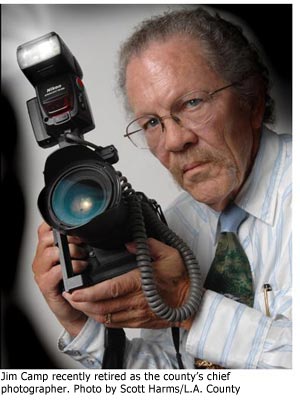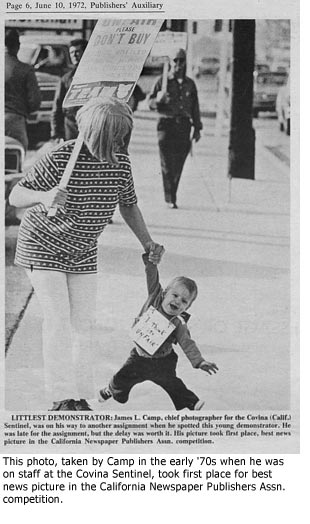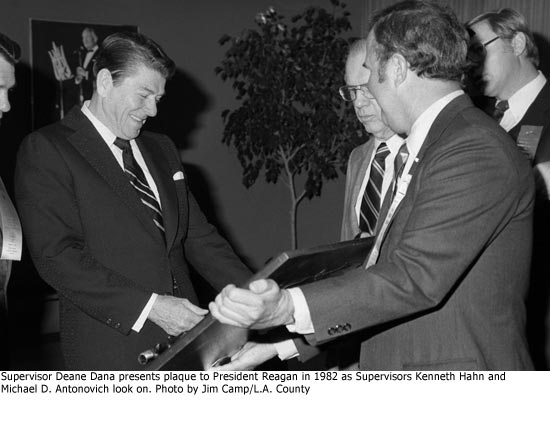Framing a career
July 21, 2010
 When Jim Camp joined Los Angeles County’s photo staff, he drew a royal flush—with emphasis on royal.
When Jim Camp joined Los Angeles County’s photo staff, he drew a royal flush—with emphasis on royal.
In his 34 years of service, Camp photographed the Queen of Thailand (“Funny story about that,” he said, describing the perfect protective triangle formed around her by three ladies in waiting.) And the King of Samoa (“Funny story, too,” involving men in skirts and tuxedo jackets with machine guns.) And assorted British royals from Prince Philip and Prince Charles to Fergie, the Duchess of York.
There was Hollywood royalty, too, like Kirk Douglas, as well as presidential royalty, from Ronald Reagan to Bill Clinton.
And, of course, there was another kind of king. By which we mean Kenny Hahn.
“He was the king of the photographs,” Camp said outside the Hall of Administration after receiving a scroll Tuesday honoring his years of work and congratulating him on his recent retirement. The late supervisor Hahn was actually part of Camp’s first photo assignment for the county: “It was the Greek Orthodox Pope, and he landed at LAX and Kenny Hahn was there to meet him.”
On Tuesday, after years of shooting countless “grip-and-grins,” showing up at infinite numbers of rubber chicken dinners and shadowing some of the most powerful local politicians in the world as they interacted with the great and near-great, Jim Camp was suddenly on the other side of the lens.
And he didn’t much like it.
“I didn’t want to do it because basically I don’t like that side of the table,” he said. “I’ve spent too many years on the other side. But Mike wouldn’t let me go.”
That would be Supervisor Michael D. Antonovich, one of 12 county supervisors whose every public move has been chronicled by Camp and his staff during the course of his county career, which started in 1976.
Antonovich publicly praised Camp for his “excellent service and dedication” to the county and cited some of his biggest accomplishments: overseeing the county’s transition to digital photography and beginning the process of archiving its “irresistible historical images.” As chief photographer, Camp supervised a unit with three photographers and two student workers.
But the heart of the job was interacting with the supervisors themselves—and witnessing the worlds they walk in.
“They’ve each had their goods, their bads, their little secret cues for us,” Camp recalled. He said that whenever Hahn would say “Just do the best you can,” he actually meant something like “Stop fussing and just shoot the picture already.”
“Good Lord, some of the stuff was just incredible,” Camp reminisced Tuesday, before launching into one of his trademark anecdotes, this one about a demonstrator who rushed the Board of Supervisors at a meeting but was stopped cold after he crashed headlong into an enormous sheriff’s deputy blocking his way. “It was one of these deputies who are wider than they are tall,” he said. “He picked [the demonstrator] up by the belt and walked out of the room with him.”
 So did that turn into an action photo of government at work? No way. “We had to be careful what we shot and what we didn’t shoot. We were there to cover the board, not news.”
So did that turn into an action photo of government at work? No way. “We had to be careful what we shot and what we didn’t shoot. We were there to cover the board, not news.”
It was a big transition for someone like Camp, now 71, who’d been a photographer for the now-defunct Covina Sentinel and the San Gabriel Valley Tribune before joining the county.
“When I was shooting news, I shot what I wanted,” he said. “Now I had to make the board members look good, no matter what.”
There were perks, of course—like being selected to photograph Reagan’s visit to the county in 1982 and being assisted by a Secret Service agent who helped him navigate walking backward down a hall while shooting photos every step of the way. “His job was, I guess, to keep me from making a fool out of myself.”
Camp was born in Michigan but grew up in California. He joined the Navy right out of high school and spent 59 days in a submarine submerged off the coast of Vladivostok during the Cold War (but that’s another story). He started with the county as a microfilm technician, and first came to the photo department on a temporary assignment. He worked a lot in the lab at the beginning but soon enough was out shooting photos, day and night.
It was the kind of schedule that could wreak havoc with the home life.
“What home life?” Camp said. “Eight to five every day, plus nights, weekends, holidays—whenever we were needed…”
“We were headed to Wyoming for one of my rare vacations, and they ran out of people to shoot an event out in Newhall,” Camp said. “I packed up the family in the camper but I stopped in Newhall and shot the event.”
Camp’s wife, Diane, who was in the audience for Tuesday’s presentation, served as his “reality check” during all those years of service, including times when “I’d get wound tighter than a tick.”
Also present Tuesday was his 15-year-old grandson Nick, who lives with Jim and Diane in Glendora.
Camp thanked his county family and his actual family for “making quite an adventure out of this.” And then he stepped outside to talk about what’s next—more time for another kind of shooting (target practice) and to finally purchase a piece of equipment that the county had provided for so many years.
“I’ve got to buy a camera,” he said.













 405 bridge work causes a stink
405 bridge work causes a stink
